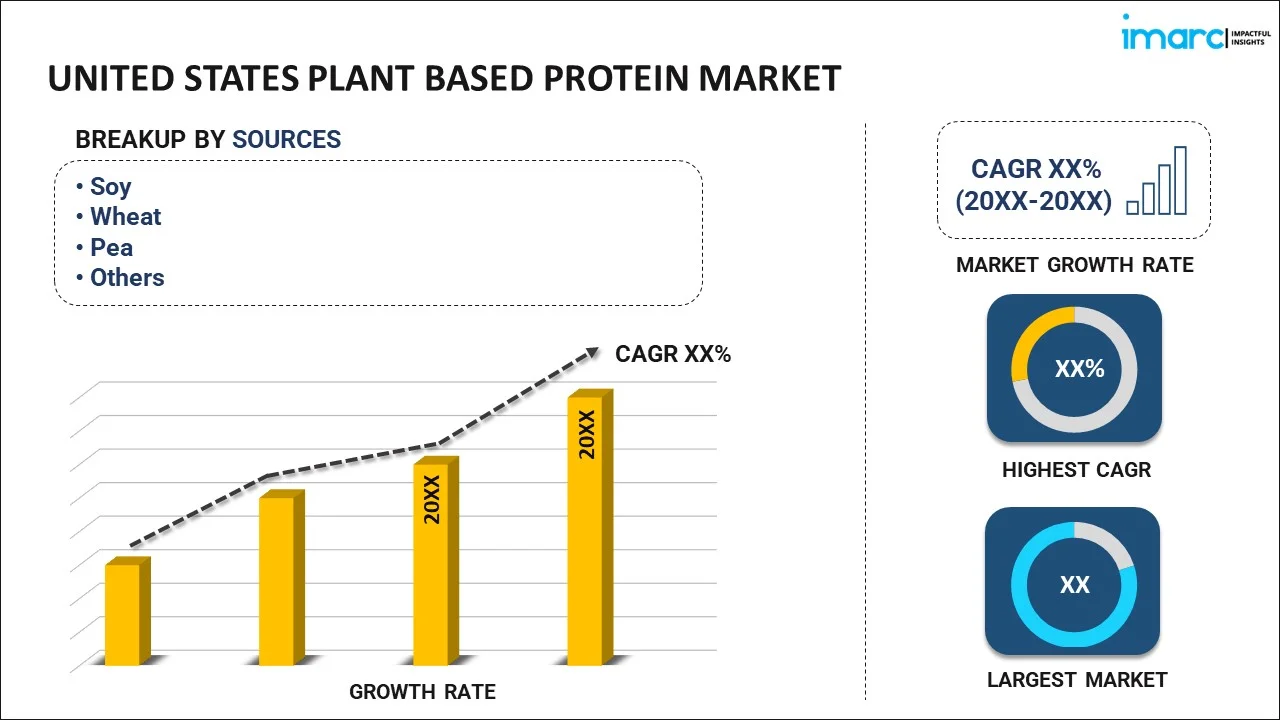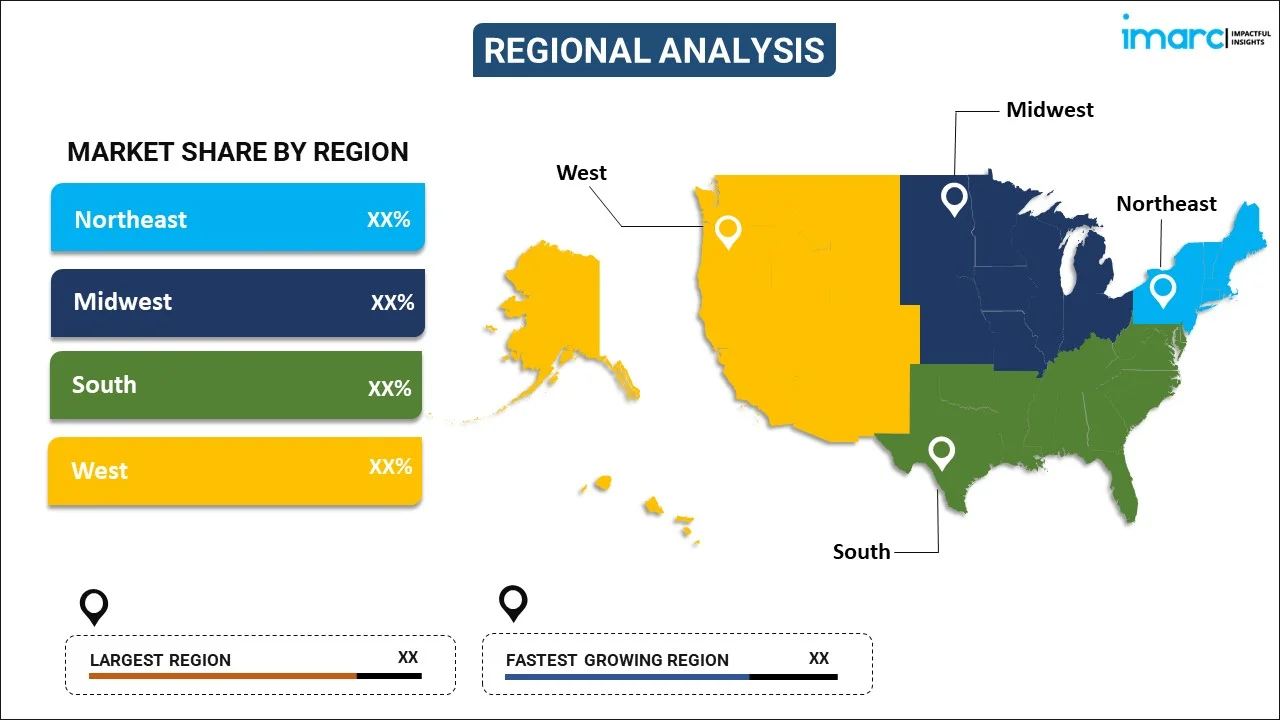
United States Plant Based Protein Market Report by Source (Soy, Wheat, Pea, and Others), Type (Concentrates, Isolates, Textured), Nature (Conventional, Organic), Application (Food, Feed), and Region 2025-2033
Market Overview:
United States plant based protein market size reached USD 3.9 Billion in 2024. Looking forward, IMARC Group expects the market to reach USD 5.5 Billion by 2033, exhibiting a growth rate (CAGR) of 3.8% during 2025-2033. The growing demand for ethically sourced food products, rising awareness about the health benefits associated with reduced meat consumption, and increasing focus on animal welfare to maintain environmental sustainability represent some of the key factors driving the market.
|
Report Attribute
|
Key Statistics
|
|---|---|
|
Base Year
|
2024 |
|
Forecast Years
|
2025-2033
|
|
Historical Years
|
2019-2024
|
| Market Size in 2024 | USD 3.9 Billion |
| Market Forecast in 2033 | USD 5.5 Billion |
| Market Growth Rate (2025-2033) | 3.8% |
Plant based protein is derived from plant sources, such as beans, lentils, wheat, rice, nuts, and seeds. It does not involve the utilization of animal-based protein obtained from meat, dairy, and eggs. It contains dietary fiber, vitamins, minerals, amino acids, and phytonutrients, providing a nutrient-rich diet. It is lower in saturated fat and cholesterol levels as compared to animal-based protein, making it a heart-healthy choice. It is suitable for individuals with food allergies or intolerances to common animal-based proteins. It offers a sustainable and nutritional alternative for consumers with vegetarian diets. It helps reduce the risk of heart disease and lower levels of low-density lipoprotein (LDL) cholesterol. It benefits individuals in controlling their calorie intake and maintaining a healthy weight. It aids in digestion, promoting gut health, and preventing constipation and other digestive issues. Besides this, it assists in building and repairing tissues in the body. As it is beneficial in lowering the risk of chronic diseases, such as type 2 diabetes, certain types of cancer, and hypertension, the demand for plant based protein is rising in the United States.
United States Plant Based Protein Market Trends:
Presently, the escalating demand for plant based protein, as its production requires fewer natural resources and generates minimal greenhouse gas (GHG) emissions, represents one of the major factors influencing the market positively in the United States. Additionally, the increasing awareness about the health benefits associated with reduced meat consumption among people is propelling the growth of the market in the country. Apart from this, there is a rise in the demand for ethically sourced food products among the masses. This, coupled with the growing adoption of plant-based proteins in a wide range of culinary applications, such as meatless burgers, tofu, lentil soups, and chickpea salads, is offering a positive market outlook in the country. Moreover, increasing preferences for plant-based protein, as it does not involve the use of antibiotics in livestock farming, is bolstering the growth of the market. In line with this, the rising focus on animal welfare among people is strengthening the market growth in the US. Furthermore, the increasing awareness among individuals about the health benefits of plant-based diets, such as reduced risk of chronic diseases and improved digestion, is providing lucrative growth opportunities to industry investors. In addition, the wide availability of plant based protein items in restaurants, cafes, and other fast food service establishments are contributing to the market growth in the country. The escalating demand for plant based proteins on account of the rising social media influence on individuals is also impelling the market growth in the US.
United States Plant Based Protein Market Segmentation:
IMARC Group provides an analysis of the key trends in each segment of the market, along with forecasts at the country level for 2025-2033. Our report has categorized the market based on source, type, nature, and application.
Source Insights:

- Soy
- Wheat
- Pea
- Others
The report has provided a detailed breakup and analysis of the market based on the source. This includes soy, wheat, pea, and others.
Type Insights:
- Concentrates
- Isolates
- Textured
A detailed breakup and analysis of the market based on the type have also been provided in the report. This includes concentrates, isolates, and textured.
Nature Insights:
- Conventional
- Organic
The report has provided a detailed breakup and analysis of the market based on the nature. This includes conventional and organic.
Application Insights:
- Food
- Meat Alternatives
- Dairy Alternatives
- Bakery Products
- Performance Nutrition
- Convenience Foods
- Others
- Feed
A detailed breakup and analysis of the market based on the application have also been provided in the report. This includes food (meat alternatives, dairy alternatives, bakery products, performance nutrition, convenience foods, and others) and feed.
Regional Insights:

- Northeast
- Midwest
- South
- West
The report has also provided a comprehensive analysis of all the major regional markets, which include Northeast, Midwest, South, and West.
Competitive Landscape:
The market research report has also provided a comprehensive analysis of the competitive landscape in the market. Competitive analysis such as market structure, key player positioning, top winning strategies, competitive dashboard, and company evaluation quadrant has been covered in the report. Also, detailed profiles of all major companies have been provided.
United States Plant Based Protein Market Report Coverage:
| Report Features | Details |
|---|---|
| Base Year of the Analysis | 2024 |
| Historical Period | 2019-2024 |
| Forecast Period | 2025-2033 |
| Units | Billion USD |
| Scope of the Report | Exploration of Historical Trends and Market Outlook, Industry Catalysts and Challenges, Segment-Wise Historical and Future Market Assessment:
|
| Sources Covered | Soy, Wheat, Pea, Others |
| Types Covered | Concentrates, Isolates, Textured |
| Natures Covered | Conventional, Organic |
| Applications Covered |
|
| Regions Covered | Northeast, Midwest, South, West |
| Customization Scope | 10% Free Customization |
| Post-Sale Analyst Support | 10-12 Weeks |
| Delivery Format | PDF and Excel through Email (We can also provide the editable version of the report in PPT/Word format on special request) |
Key Questions Answered in This Report:
- How has the United States plant based protein market performed so far and how will it perform in the coming years?
- What has been the impact of COVID-19 on the United States plant based protein market?
- What is the breakup of the United States plant based protein market on the basis of source?
- What is the breakup of the United States plant based protein market on the basis of type?
- What is the breakup of the United States plant based protein market on the basis of nature?
- What is the breakup of the United States plant based protein market on the basis of application?
- What are the various stages in the value chain of the United States plant based protein market?
- What are the key driving factors and challenges in the United States plant based protein?
- What is the structure of the United States plant based protein market and who are the key players?
- What is the degree of competition in the United States plant based protein market?
Key Benefits for Stakeholders:
- IMARC’s industry report offers a comprehensive quantitative analysis of various market segments, historical and current market trends, market forecasts, and dynamics of the United States plant based protein market from 2019-2033.
- The research report provides the latest information on the market drivers, challenges, and opportunities in the United States plant based protein market.
- Porter's five forces analysis assist stakeholders in assessing the impact of new entrants, competitive rivalry, supplier power, buyer power, and the threat of substitution. It helps stakeholders to analyze the level of competition within the United States plant based protein industry and its attractiveness.
- Competitive landscape allows stakeholders to understand their competitive environment and provides an insight into the current positions of key players in the market.
Need more help?
- Speak to our experienced analysts for insights on the current market scenarios.
- Include additional segments and countries to customize the report as per your requirement.
- Gain an unparalleled competitive advantage in your domain by understanding how to utilize the report and positively impacting your operations and revenue.
- For further assistance, please connect with our analysts.
 Inquire Before Buying
Inquire Before Buying
 Speak to an Analyst
Speak to an Analyst
 Request Brochure
Request Brochure
 Request Customization
Request Customization




.webp)




.webp)












